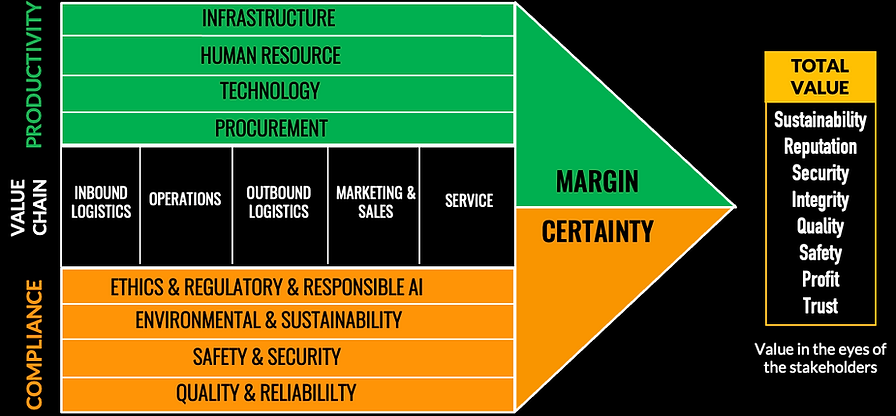COMPLIANCE
THE TOTAL VALUE ADVANTAGE™
Investing in the Opportunity to Succeed
There is one question that is often asked, "How does compliance generate a return on investment?"
Where is the ROI for compliance?
This question asks us to evaluate compliance in the context of financial terms such as profit, a basic measure of businesses success and purpose.
However, there are other outcomes that businesses endeavour to create such as: reputation, integrity, quality, safety, security, sustainability, and ultimately stakeholder trust.
Therefore, when considering compliance ROI, it's necessary to also include all the value that compliance protects and ensures, not only profit. We call this Total Value.
Delivering on Total Value is not only important, it's essential for competitive advantage in today's marketplace. Building on Michael Porter's Cost and Differentiation advantages as part of Value Chain Analysis, we developed the concept of Total Value Advantage.
This approach recognizes that competitive advantage goes beyond just improving price and product features. It encompasses all aspects that deliver value to a company's stakeholders, fostering trust and long-term mission success.

Total Value Chain Analysis
Compliance Protects the Opportunity to Succeed
Effective compliance programs improve the probability of mission success by potecting the opportunity to succeed.
Here's how compliance contributes to mission success:
-
Safety: Robust safety programs protect employees, customers, and the public. This translates to fewer accidents, injuries, and lawsuits, creating a safer work environment and building trust with all stakeholders.
-
Security: Implementing strong cybersecurity measures safeguards sensitive information, financial assets, and critical infrastructure. This protects customer data and brand reputation, fostering trust in the company's ability to handle information responsibly.
-
Sustainability: Companies that prioritize environmental responsibility by reducing their carbon footprint, minimizing waste, and using resources efficiently gain a competitive edge. Customers increasingly support companies with strong sustainability practices.
-
Quality: Delivering consistently high-quality products or services builds trust with customers. They know they can rely on the company to meet or exceed their expectations, leading to customer satisfaction and retention.
-
Regulatory Adherence: Proactive efforts to comply with all regulations (environmental, labour, product safety, etc.) demonstrate a commitment to ethical practices. This avoids fines, legal trouble, and reputational damage, maintaining trust with regulators and the public.
-
Environmental Responsibility: Minimizing pollution, promoting resource conservation, and investing in renewable energy sources contribute to a healthier environment. This resonates with environmentally conscious consumers and builds a positive brand image.
-
And other programs such as, Ethics, Reliability, AML, etc.
Differentiation and Cost Savings Through Compliance Practices:
-
Differentiation: focusing on Total Value enables companies to differentiate themselves from competitors who solely focus on price or basic features. This approach attracts customers who value responsible practices and are willing to pay a premium for them.
-
Cost Savings: While there may be initial investment costs, responsible practices can lead to long-term cost savings in the following ways:
- Safety: Investing in safety measures reduces accidents, injuries, and workers' compensation claims.
- Security: Strong cyber-security prevents costly data breaches and protects company assets.
- Sustainability: Energy efficiency initiatives lower operational costs. Recycling reduces waste disposal expenses.
- Regulatory Adherence: Proactive practices avoids fines and legal fees.
Overall, Total Value Advantage represents a shift in focus from just cost or product features to a holistic approach that ensures delivery of what is valued. By prioritizing responsible practices, companies can build trust with stakeholders, differentiate themselves in the marketplace, and ultimately achieve sustainable mission success.
The Total Value Advantage makes sure what is valued is created and protected.
Now, how much is that worth to you or your customers?